Solar eclipse of November 23, 2003
| Solar eclipse of November 23, 2003 | |
|---|---|
 Map | |
| Type of eclipse | |
| Nature | Total |
| Gamma | -0.9638 |
| Magnitude | 1.0379 |
| Maximum eclipse | |
| Duration | 117 sec (1 m 57 s) |
| Coordinates | 72°42′S 88°24′E / 72.7°S 88.4°E |
| Max. width of band | 495 km (308 mi) |
| Times (UTC) | |
| Greatest eclipse | 22:50:22 |
| References | |
| Saros | 152 (12 of 70) |
| Catalog # (SE5000) | 9516 |
A total solar eclipse took place on November 23, 2003 with a magnitude of 1.0379. A solar eclipse occurs when the Moon passes between Earth and the Sun, thereby totally or partly obscuring the image of the Sun for a viewer on Earth. A total solar eclipse occurs when the Moon's apparent diameter is larger than the Sun's, blocking all direct sunlight, turning day into darkness. Totality occurs in a narrow path across Earth's surface, with the partial solar eclipse visible over a surrounding region thousands of kilometres wide. It was visible from a corridor in the Antarctic region. A partial eclipse was seen from the much broader path of the Moon's penumbra, including the southern tip of South America and most of Australia.
For most solar eclipses the path of totality moves eastwards. In this case the path moved south and then west round Antarctica.
Images

Animated map
Related eclipses
Solar eclipses 2000-2003
Each member in a semester series of solar eclipses repeats approximately every 177 days and 4 hours (a semester) at alternating nodes of the Moon's orbit.
Note: Partial solar eclipses on February 5, 2000 and July 31, 2000 occur in the previous lunar year set.
| Ascending node | Descending node | |||
|---|---|---|---|---|
| Saros | Map | Saros | Map | |
| 117 | July 1, 2000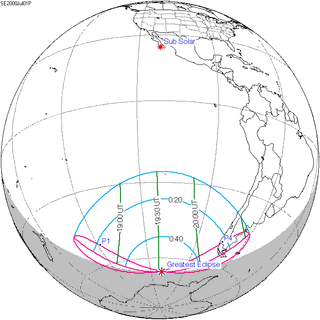 Partial (south) |
122 | December 25, 2000 Partial (north) | |
127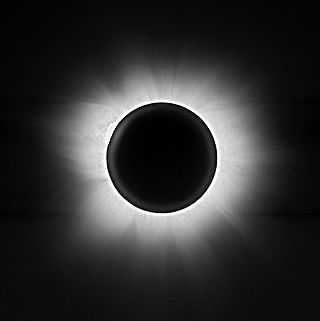 Totality from Zambia | June 21, 2001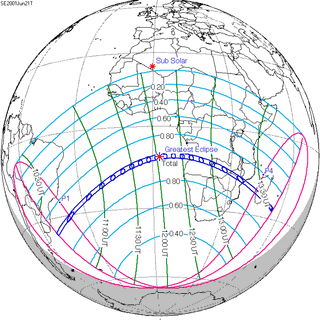 Total |
132 Partial from Minneapolis, MN | December 14, 2001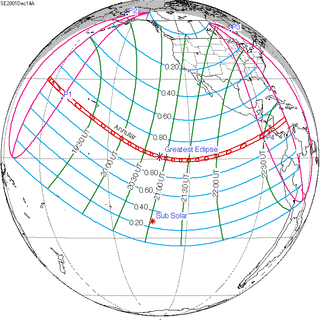 Annular | |
137.jpg) Partial Los Angeles, CA | June 10, 2002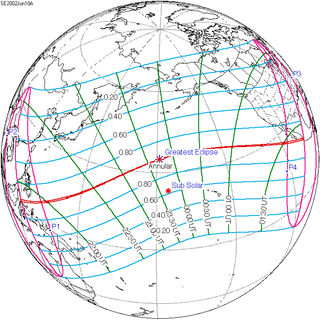 Annular |
142 | December 4, 2002 Total | |
147 Partial from Belfort | May 31, 2003 Annular |
152 | November 23, 2003 Total | |
Metonic series
The metonic series repeats eclipses every 19 years (6939.69 days), lasting about 5 cycles. Eclipses occur in nearly the same calendar date. In addition the octon subseries repeats 1/5 of that or every 3.8 years (1387.94 days).
This series has 22 eclipse events between September 12, 1931 and July 1, 2011.
| September 11-12 | June 30-July 1 | April 18-19 | February 4-5 | November 22-23 |
|---|---|---|---|---|
| 114 | 116 | 118 | 120 | 122 |
 September 12, 1931 |
 June 30, 1935 |
 April 19, 1939 |
 February 4, 1943 |
 November 23, 1946 |
| 124 | 126 | 128 | 130 | 132 |
 September 12, 1950 |
 June 30, 1954 |
 April 19, 1958 |
 February 5, 1962 |
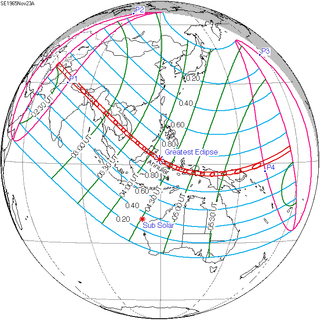 November 23, 1965 |
| 134 | 136 | 138 | 140 | 142 |
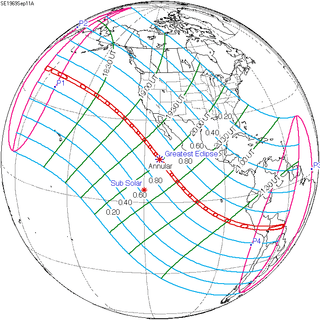 September 11, 1969 |
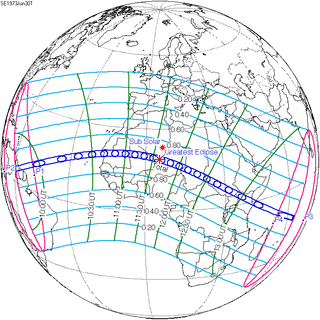 June 30, 1973 |
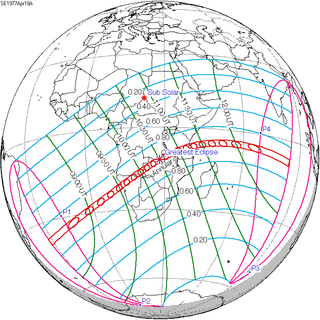 April 18, 1977 |
 February 4, 1981 |
 November 22, 1984 |
| 144 | 146 | 148 | 150 | 152 |
 September 11, 1988 |
 June 30, 1992 |
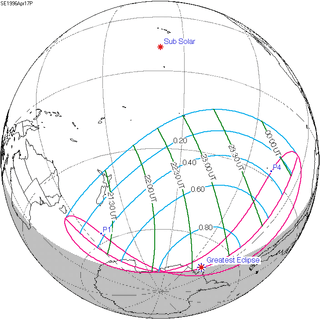 April 17, 1996 |
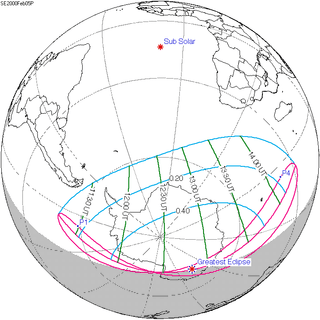 February 5, 2000 |
 November 23, 2003 |
| 154 | 156 | |||
 September 11, 2007 |
 July 1, 2011 |
Notes
References
- Fred Espenak and Jay Anderson. "Total Solar Eclipse of 2003 November 23". NASA, July 2003.
- Earth visibility chart and eclipse statistics Eclipse Predictions by Fred Espenak, NASA/GSFC
- Google Map
Photos:
- Prof. Druckmüller's eclipse photography site. Flight over Antarctica
- Images from Antarctica by Crayford Manor House Astronomical Society
- APOD 8/5/2004, An Antarctic Total Solar Eclipse
- APOD 11/27/2003, The Long Shadow of the Moon, Total solar eclipse from satellite over Antarctica
| Wikimedia Commons has media related to Solar eclipse of 2003 November 23. |

